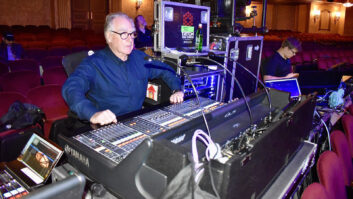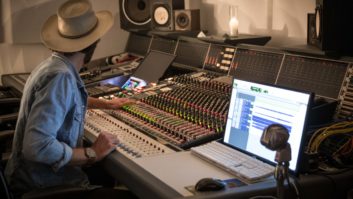VAN NUYS, CA—Sound City is dead; long live Sound City!
Contrary to the popular misconception spread by Dave Grohl’s 2013 documentary chronicling the purchase and relocation of the studio’s iconic Neve desk to the Foo Fighters’ private facility, Sound City is far from dead. True, the studio has been closed to the public since producer and label owner Kevin Augunas moved in and renamed it Fairfax Recordings in 2011. But now that Augunas has moved out and left the music industry, Sound City Studios has been relaunched as a commercial enterprise.
Sound City Studios was opened by partners Tom Skeeter and Joe Gottfried, who acquired the former amplifier manufacturing and test facility from Vox in 1969. The studio got its big break in 1975 when Fleetwood Mac recorded its self-titled album there, opening the floodgates to a stream of artists who recorded the mainstays of every classic rock radio station’s playlist. In 1991, Nirvana’s Nevermind cemented Sound City’s status as one of the world’s top drum-tracking rooms.
Skeeter’s daughter, Sandy, president of Sound City, Inc., has partnered with record executive, producer and music publisher Olivier Chastan to relaunch the studio. Skeeter owns the entire complex—four low buildings around a courtyard parking lot that also house studios occupied by producer Matt Wallace, a 10-year resident, drummer Matt Chamberlain and others.
“My equipment is my contribution; Sandy is contributing the building,” says Chastan of the new partnership. Chastan, a former partner at Waterfront Studios in New York’s Hudson Valley, has relocated much of that facility’s inventory to Sound City. “Console, tape machine, monitors—those are the heart of any studio,” he says.
Sound City’s A and B control rooms are equipped with analog mixing consoles designed by Dick Swettenham, who established Helios Electronics in 1968, initially to equip London’s famed Olympic Studios. Helios desks were soon adopted by top U.K. facilities including Apple Studios, Strawberry Studios and many others. The 1969 Helios Type 69 20x12x20 in Sound City’s B room was the original mixing desk at Island Studios in Basing Street, London.
Astonishingly, Chastan found the console in California on Craigslist. The only line mixer that Helios built, says Chastan, it has no mic preamps or monitor section and was intended for Island’s “reduction room,” which never got built. In 1971, it shipped to Studio 70 in Munich, Germany, by which time tracks by Led Zeppelin, Free, Black Sabbath and others had passed through it, he says. At Studio 70, the desk was used to mix Kraftwerk and Donna Summer, among others.
“I think for people who work in Pro Tools, it’s much more logical than a regular console. You take the mic out from the live room, into an external preamp, into the desk, route through a channel, fader up and down, into Pro Tools. It’s a nice intermediary desk,” says Chastan. He plans to have Electrodyne Audio’s Ken Hirsch, who is responsible for the console’s restoration, add 12 group buses, with inserts. “But the essence of the desk will be totally unchanged.”
The 1969 Helios Type 69 in Sound City’s B room has passed through numerous studios over the years and mixed the likes of Led Zeppelin, Free, Black Sabbath, Kraftwerk and Donna Summer along the way.

Waterfront’s 1973 Helios Type 69, now in Sound City’s A room, includes 26 preamp channels, 24 tape returns, eight groups and two stereo echo returns, plus a built-in plate reverb. It, too, has traveled around Europe and on to North America.
“It’s incredibly clean and totally original, with no modifications done to it,” says Chastan, noting that technician David Amels restored the board to its original spec. “It looks arcane but it’s a very simple console.”
For clients unfamiliar with the desks, studio manager David Andersen, formerly Henry Hirsch’s assistant at Waterfront, is on hand. “Dave has a lot of experience with the desk and is here every day. He can guide people through it as the engineer, or just to supervise as second engineer,” says Chastan. Producer, engineer and mixer Gavin Paddock, who has been making records at Sound City for more than five years, is also on staff.
Studios A and B both offer Pro Tools|HD 10, but for those who prefer tape, Ampex MM1000 and 3M M79 16-track, 2-inch and 3M M79 2-track, half-inch machines are normaled through the A room’s Helios. There is also a Studer A800 24-track, 2-inch machine available. An echo chamber is also patchable from both studios.
Augunas invested in some restoration work while in residence, but the rooms are materially unchanged. Audio and acoustical engineer George Augspurger, who has been involved with Sound City since the seventies, is consulting to ensure everything meets spec. His JBL-equipped main monitors grace control room B.
Chastan recently added a Trinnov Audio system to optimize speaker performance in control room A. “It allows us to adapt modern, high-gain monitors to the room, which was designed in the sixties, and make sure we don’t have comb filtering or too much bass. If somebody brings their own speakers, they can shoot them with the Trinnov and correlate with the ATC SCM200 mains, to make sure they translate.”
Sound City Studios
soundcitystudios.com
Other Equipment Highlights
● Converters: Lynx Aurora 16, UA 2192 Mastering
● Mics: AKG, Altec, Beyerdynamic, B&O, Coles, EV, Fairchild, Neumann, Placid Audio, Royer, Sennheiser, Shure, Tannoy
● Preamps: Ampex 440, Anamod Realios A9031, 9033
● EQ: Amels Audio RCA, Electrodyne 251a
● Compressors: Anamod AM660, dbx 160X, Neumann U473a
● Reverbs: Echo chamber (A & B), EMT 140 Stereo, Ecoplate III
● Effects: Roland SVC-350 Vocoder, SRE-555 Tape Echo; TC Electronic 2290, D-Two Delays
● Monitors: ATC SCM20ASL (B), Altec 604c mono reference (A & B)






